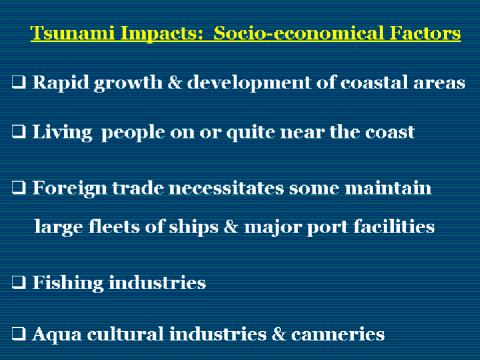| front |1 |2 |3 |4 |5 |6 |7 |8 |9 |10 |11 |12 |13 |14 |15 |16 |17 |18 |19 |20 |21 |22 |23 |24 |25 |26 |27 |28 |29 |30 |31 |32 |33 |34 |35 |36 |37 |38 |39 |40 |41 |42 |43 |44 |45 |46 |47 |48 |review |
 |
"The
"extensive coastal boundaries", the "number of islands", the "long
coastlines of countries containing a number of vulnerable engineering
structures", the "numerous large ports", the "productive fishing" and "aqua
cultural industries" and the "great density of population in coastal areas"
can only place them in a very vulnerable position. We have witnessed in the last twenty years rapid growth and development of the coastal areas in most of the developing or developed Pacific nations. This is the result of a population explosion and of technological and economic developments that have made the use of the coastal zone more necessary than before. Most of the people in the Pacific countries live on or quite near the coast since the interior is often mountainous and most of the good flatland is in the form of coastal plains. Many of these countries have populations with a natural maritime orientation. For many of these countries, foreign trade is a necessity and some maintain large fleets of ships and have major port facilities. Many of the Pacific island countries and those with extensive continental
coastlines depend also on transport by small coastal ships necessitating
many small ports to facilitate inter-island and coastal trade as well.
Countries like Japan, for example, maintain many ports and have extensive
shipbuilding facilities, electric plants, refineries and other important
structures. Similarly, many of the other developing and developed countries of the Pacific have harbors as bases for their large fishing industries. Peru, for example, at the port of Callao near Lima, maintains a large fleet for anchovy fishing. Callao is located near a strong seismic and potentially tsunamigenic region. Finally, when we also note that a number of coastal sites throughout the Pacific have begun aqua cultural industries and canneries, we can conclude that this combination of factors makes these developed and developing Pacific islands and continental Pacific nations socially and economically vulnerable to the threat of tsunami. " Readings suggestion (by: G. Pararas-Carayannis): "Violent Forces in Nature", Ch. 11, Lamond Publications, 1986, p. 157-169. "Impact of Science on Society", Vol. 32, No.1, 1982, p 71-78. Citation source: http://www.drgeorgepc.com/TsunamiImpactSociety.html |